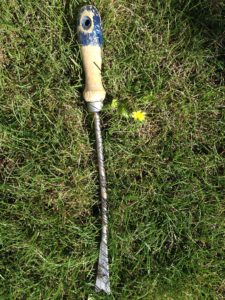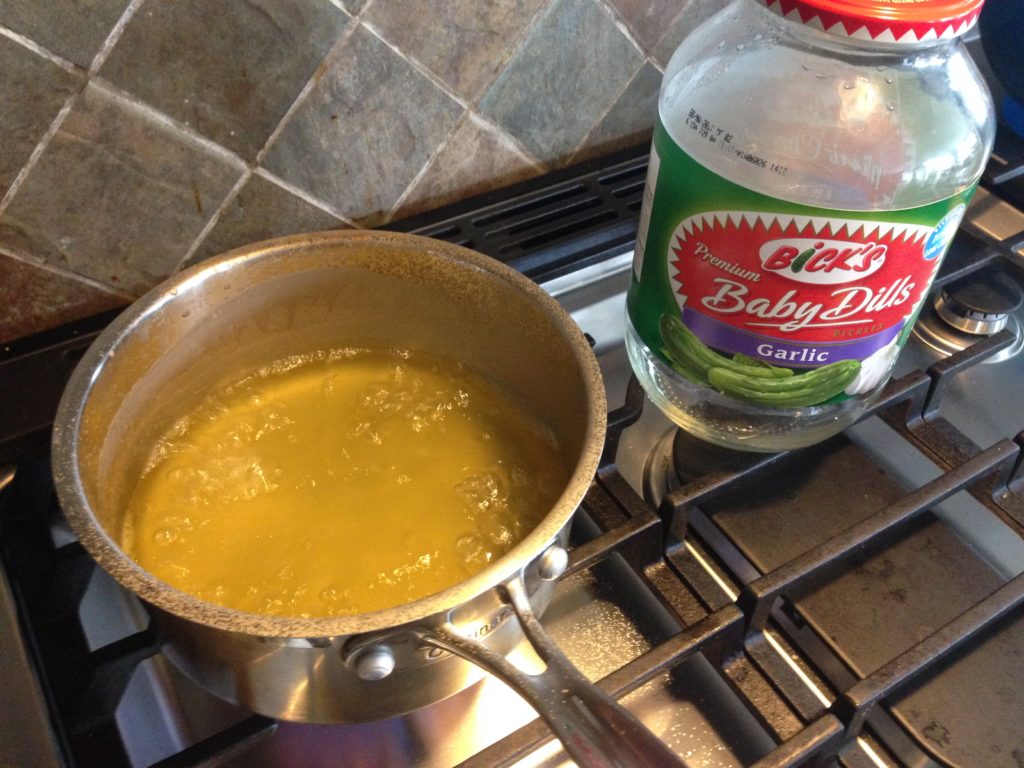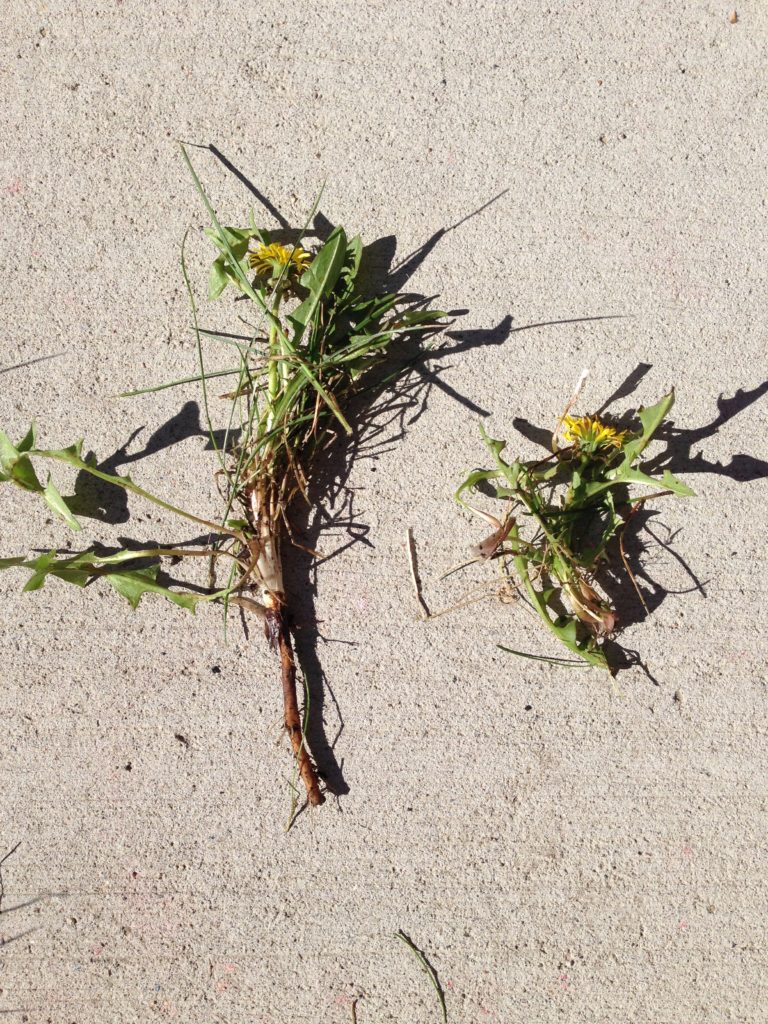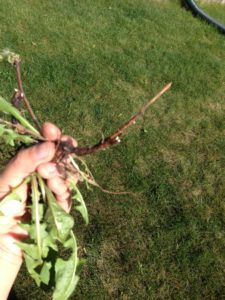I have been battling with dandelions for nearly 20 years, since I first became a homeowner. My approach has evolved over the decades from unreservedly and liberally using herbicides to various shades of manually managing them by pulling, mowing, or otherwise “natural” methods of controlling them. We moved to our current house when my son was a baby and have mostly tried to control the dandelion weed population by natural methods here.

Every year, I struggle with the temptation to spray the lawn and be done with it. And every year, I instead opt to try something new in my quest to manage my dandelion problem without using harsh herbicides. This reluctance is shared by a growing number of people, as we discover that the “quick and easy” chemical solutions our parents were sold on actually have underlying and often long-standing and extensive consequences or that “Better Living Through Chemistry” is not always true. My journey to this conviction was no different.
What’s My Problem With Herbicides?
2,4-D and glyphosate are arguably the most commonly-used herbicides (marketed under a number of trade names). 2,4-D is commonly used for dandelion control because it is selective to broadleaf weeds but leaves grass alone. The mechanism of action for 2,4-D is death caused by uncontrolled growth. Um, that’s basically the definition of cancer. The mechanism of action for glyphosate is inhibition of the synthesis of 3 amino acids which are needed for protein synthesis and synthesis of compounds necessary for cell replication and metabolism: very basically, inhibition of processes necessary for life.
Yet, the research is contradictory. Even amongst international agencies, there is disagreement. In 2015, the World Health Organization’s International Agency for Research on Cancer classified glyphosate as “probably” carcinogenic to humans and 2,4-D as “possibly” carcinogenic to humans. Other branches of the WHO later ruled (2016) that glyphosate is unlikely to cause cancer in humans through diet, and the EPA had earlier (2007) ruled that existing data do not show a link between 2,4-D and cancer. There are also arguments that these compounds affect plant biochemical pathways only and don’t have the same effects on mammals. Fair enough. But not having the same effects does not necessarily mean not having any adverse effects.
My thought process about the dangers of herbicidal sprays is much simpler and goes something like this:
Stated simply, something that does not naturally occur in nature and significantly alters the biochemical pathways of a living thing to the extent that the living thing is killed, cannot be good for humans.
When I look through the discoveries made even in the past 40 years, for example, time and again we have discovered that something we once thought was safe and had no effect, actually has long-standing and serious consequences for animal populations and ultimately us. Look at what we have discovered about PCBs, DDT, and Dioxins. About pesticides we once thought only impacted animals (and who cares about them, right? sigh) but had no deleterious effects on humans. About the impact on aquatic life (and, if you follow my blog, ultimately on humans too!) of seemingly harmless compounds like detergents and phosphates. About all the things that work in fine balance in our ecosystem, that are disrupted when even just one thin arm of that ecosystem is taken out. And in my specific case, given my convictions about the negative and largely unrecognized effects of detergents, I am particularly hesitant to spray herbicides because they often contain detergents to break the surface tension of the liquid and help spread the spray.
And Yet, I’m Still Tempted to Spray
After having said all that, I admit that I am still tempted to spray. Every year, at around this time when the dandelions are at their busiest; when I spend an hour of back-breaking (literally, my back and knees ache after I’m done) work picking dandelions, and come back the next morning to discover even more dandelions have now flowered, like I made absolutely no dent in them; when I dig a big, thick dandelion and discover an indentation in the ground where it is growing and realize I’ve dug this same one year over year and it made no long-lasting difference; when I stand up after an hour thinking “that’s enough for now, I need to move on with my day” and can still see dozens of untouched dandelion bodies that haven’t flowered yet; when I finish in the front yard and then realize I still need to tackle the back yard; when everyday in May and early June my precious spare time is spent digging dandelions rather than tending my garden, writing my blog, or enjoying time with my children; when I cannot shake the growing feeling that I’ve been doing this “natural thing” all wrong and am probably making the dandelion problem worse with my actions … I am tempted to spray.

Maybe I can just spray one year to once and for all kill all the buried taproots, and then go back to my natural solutions, I think. Maybe I can just spray at the end of the season when the kids aren’t on the lawn, I think. Maybe I can just spray the front and never let the kids play on it, relegating them to our backyard, I think. Maybe, maybe, maybe.
This year, I haven’t given into my temptation to spray yet. Like every year past, this year I have decided to step up my natural efforts and, armed with better knowledge, see if this is the year that I will get the advantage over these dandelions in a safe, natural way.
All The Natural Approaches I’ve Tried
Just a recounting of all the approaches I’ve tried in the past is dizzying:
- Merely plucking the heads off the dandelions so at least they don’t go to seed and spread
- Mowing frequently so the dandelions don’t get a chance to go to seed
- Spraying them with various concentrations of vinegar
- Spraying them with some combination of home-made vinegar, salt and detergent solution
- Digging them
- Digging them, filling the indentation with soil, re-seeding with grass
- Attempting to outcompete the weeds with grass by improving grass health: leaving lawn clippings on the lawn after mowing, re-seeding the entire surface of the lawn with grass seed
- Spreading corn meal gluten all over the lawn as a pre-emergence treatment (prevents seeds from taking root)
- Adding fertilizer to the lawn early in the season and at the end of the season in an attempt to strengthen the lawn to outcompete the dandelions

I Realized I Was Inadvertently Making the Problem Worse!
This year I’ve been working on my dandelion problem with a bit more knowledge under my belt (both from concepts discussed in our Grow Food Calgary class and reading on my own). That knowledge combined with continuing to see that I’m digging the same old places year after year, and that some of the biggest, most gangly dandelions come out of the same old places, I now actually think my past actions have made the problem worse. Here’s why.
- When I merely plucked the heads off before they seeded, or relied on mowing to control the dandelion problem, I was actually dead-heading the dandelions. Just like we would dead-head our basil plant to encourage more bushy growth, I was pretty much doing this to my dandelions. No wonder there are many that are just so thick, wide, and have so many flowering heads!
- When I dug them, I often did not dig deep enough to get the entire taproot out, so in subsequent years, the dandelion came back in the same place, with an increasingly stronger and more extensive taproot to support it
- When I used homemade sprays or very concentrated vinegar solutions, all I ended up doing was killing the grass around the dandelion too. I don’t think these sprays are strong enough to get to the root to kill it, so I was just leaving a dead spot ready for new dandelion seeds to take root, in addition to the re-emergence of the old plant from the left-over taproot
- When I dug them and filled the dent with soil and then reseeded grass seed, I filled with very poor quality, dead dirt. It was the cheapest stuff we could find at the store and had big chunks of unbroken woody bits. The fact that I’ve usually left the taproot in the ground and tried to grow grass seed on top of that, and in dead dirt that doesn’t support growth, to boot … is it any wonder this didn’t work?

What I’m Trying This Year
So this year I am going to try to actually dig out the full taproot. This takes a lot more time and effort, and many times I worry that I’ve left small branch offshoots or even the very end of the taproot in place. When the root comes out and I see the white latex-like bleeding from parts of the root, my heart sinks. I think there’ll be another dandelion there next year, just hopefully smaller.

Earlier in the season, I thought to squirt some of my concentrated pickle solution down the hole. I’m not convinced this actually helps, and then I’m also putting detergent on my lawn where my kids play and killing lawn around the hole, no matter how carefully I squirt this stuff. I probably won’t continue with this.
My next step will be to cover the indents with corn meal gluten to prevent seeds from taking root in the exposed dirt/dent. After some time and this has broken down a bit, maybe I’ll re-seed the dent with grass seed — only after putting some good quality soil into the dent first! I’m not actually sure whether I should prioritize putting down the corn meal gluten or soil/grass seed. I’m not sure how long to wait after putting down the corn meal gluten to try to re-seed, either.
From what I’ve learned in my gardening class, theoretically I should also be able to encourage a healthy lawn by sprinkling good quality soil, finished compost, worm castings and maybe even the compost liquid from a worm farm, onto the lawn and then reseeding with grass seed. I’m not ready for that yet because I need to prioritize using those amendments for my garden soil first.
And Yet, Back to the Temptation to Spray
But before all that will really work, I think I need to get the existing dandelion problem with all the thick and extensive taproots that are already in place below ground, under control first! Now that I’m hopefully not making the problem worse by dead-heading the dandelions and leaving large chunks of taproots in the ground, will it eventually get better and better every year? Will it be another several years of back-breaking work before I gain the upper hand on the dandelions? Sure makes me consider spraying — just once, just one year. Then, I think, I can start with a clean slate. The internal debate just never ends!
